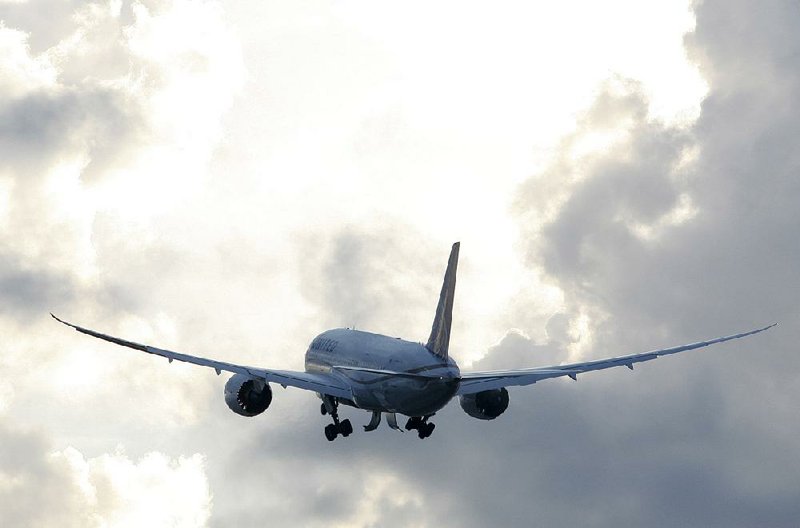LITTLE ROCK — U.S. regulators said Friday they will perform a far-reaching review of the design, manufacturing and assembly of Boeing Co.’s 787 Dreamliner after a fire on a Japan Airlines Co. jet this week and several incidents last year.
“We are confident about the safety of this aircraft, but we’re concerned about these incidents and we will conduct the review until we’re completely satisfied,” Michael Huerta, head of the Federal Aviation Administration, said at a news conference in Washington.
The FAA is looking to reassure itself, regulators in other countries and the flying public that Boeing’s newest and most technologically complex jet is safe. The 787 has become Boeing’s fastestselling model ever, with 848 orders through the end of 2012, according to the planemaker’s website. There are now 50 in service.
The examination stops short of emergency actions such as mandatory fixes or a fleet grounding that the Washington-based FAA has imposed after some aviation accidents. The U.S. National Transportation Safety Board classified the fire in Boston as an “incident,” not an accident.
“I believe this plane is safe and I would have absolutely no reservations of boarding one of these planes and taking a flight,” Transportation Secretary Ray LaHood said at the news conference.
Boeing shares fell $1.93, or 2.5 percent, to close at $75.16. The Chicago-based planemaker’s shares gained 2.8 percent in the 12 months that ended Thursday.
Regulators in their review will place special emphasis on the electrical systems, batteries and power distribution panels in the Dreamliner and how the electrical and mechanical systems of the airplane work together, Huerta said.
Details of how many people will be involved in the review and how long it will take weren’t released. The evaluation probably will start in Seattle, home to the FAA office that certified the 787 and to Boeing’s commercial hub, and “may expand to other locations over the course of several months,” the agency said in a statement. Boeing engineers will participate in the review process.
An analyst at Stifel Nicolaus & Co. in New York on Friday said this is a good time to buy Boeing shares, predicting the review would bolster confidence in the Dreamliner.
“If the review leads to changes, we think that potential changes, if any are determined necessary, will not result in a material expense or delay in ramping production rates to the target of 10 per month by the end of 2013,” Stephen Levenson said in a note.
The FAA review is in addition to a safety-board probe of the Monday fire that the agency said caused severe damage to the battery pack area of the 787 after passengers disembarked in Boston after a flight from Tokyo. A couple of jets were grounded last month by a power fault, which Boeing said this week it had traced to flaws in power panels.
“We have complete confidence in the 787 and so do our customers,” Boeing Commercial Airplanes President Ray Conner said at the news conference.
This isn’t the first time the FAA has examined the safety of a new airplane model after its introduction, Huerta said, who didn’t identify previous examples. The Dreamliner made its commercial debut in late 2011.
“In recent times, we haven’t had any type of review like this,” said Kevin Hiatt, a retired airline pilot who is president of the Flight Safety Foundation in Alexandria, Va. “It’s very prudent.”
The review also gives the FAA a chance to examine its own rules for aircraft design and certification, Hiatt said.
“You’ve got rules at the FAA that haven’t been changed since the propeller days,” he said. “We’re now looking at the most modern, advanced jet airliner ever produced and we’re still using processes and procedures that may need a little bit of a review.”
The Dreamliner conserves fuel by using five times more electricity than other similar jets and by saving weight with a fuselage and wings made from composite materials, not aluminum. Some existing FAA regulations didn’t cover the new technologies, so the plane was certified with multiple “special conditions.”
Those conditions as well as the way the FAA approved the jet will also be reviewed, Huerta said. The agency spent 200,000 personnel hours reviewing, testing and certifying the 787, he said.
The 787’s use of lithium-ion batteries set it apart from other models. Boeing got regulators’ permission to use the batteries in the jet in 2007, three years after passenger planes were barred from carrying nonrechargeable types as cargo because of their flammability.
Only lithium batteries can provide a high-energy start and be recharged quickly to meet the jet’s needs, Mike Sinnett, the chief engineer for the Dreamliner, said this week.
United Continental Holdings Inc. has “complete confidence in the 787 and in the ability of Boeing, with the support of the FAA, to resolve these early operational issues,” said Megan McCarthy, a spokesman for the Chicago-based carrier. United continues to operate all six of its Dreamliners as scheduled, she said.
Business, Pages 27 on 01/12/2013
